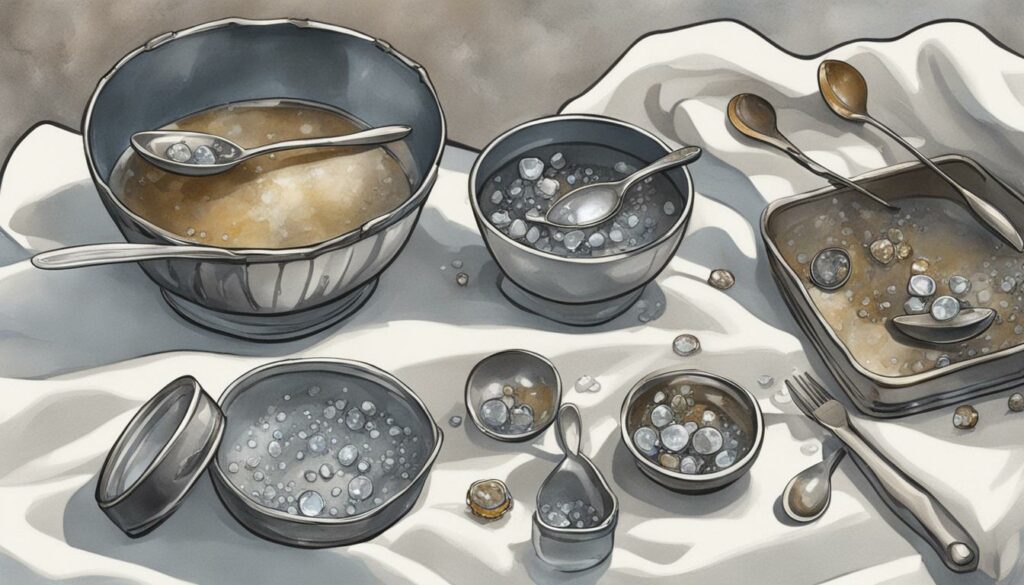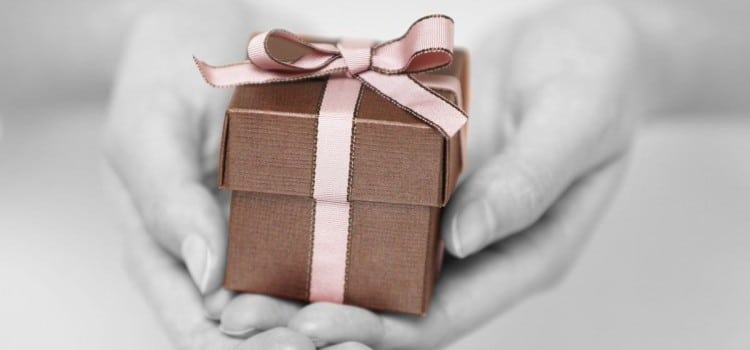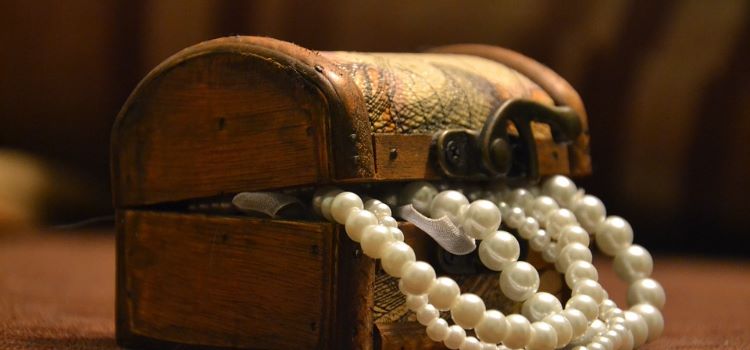Welcome to my step-by-step guide on how to fix tarnished jewelry at home. Whether you have a favorite silver necklace or a treasured antique bracelet, I’m here to help you restore their shine and beauty. With a few simple DIY jewelry cleaning techniques, you’ll be able to repair your tarnished jewelry without spending a fortune. Say goodbye to dull and discolored pieces, and hello to dazzling accessories that will make heads turn!
Before we dive into the cleaning process, it’s important to understand why jewelry tarnishes and how to prevent it. Tarnish occurs when metals react with substances in the air, such as sulfur. Factors like humidity and contact with cosmetic products can speed up the tarnishing process. But don’t worry, I’ll also share some tips on how to prevent tarnish and keep your jewelry looking its best for years to come.
So, grab your tarnished treasures, and let’s get started on restoring their shine. Follow along as I walk you through the aluminum foil method, explain the science behind it, and share some alternative cleaning methods to suit your preferences. Get ready to breathe new life into your jewelry collection!
Why Does Jewelry Tarnish?
Tarnish occurs on jewelry when the metal comes into contact with substances such as sulfur, oils, and moisture. This causes a chemical reaction that forms a layer of tarnish on the surface of the jewelry. Factors such as exposure to air, humidity, and contact with cosmetic products can accelerate the tarnishing process. By properly storing and cleaning jewelry, it is possible to minimize tarnish and maintain its original shine.
The Causes of Tarnish
Tarnish on jewelry is primarily caused by a chemical reaction between metal and elements in the environment. When jewelry made of metals like silver or copper comes into contact with substances such as sulfur, oils, and moisture, it undergoes a process known as oxidation. This chemical reaction results in the formation of a layer of tarnish on the surface of the jewelry. Exposure to air, humidity, and certain chemicals found in perfumes, lotions, and cleaning products can accelerate this process.
Silver jewelry, in particular, is prone to tarnishing due to its composition. Pure silver is too soft to be used in jewelry, so it is often combined with other metals, such as copper, to increase its durability. The presence of these additional metals makes silver more susceptible to tarnish. When silver reacts with sulfur compounds in the air, it forms silver sulfide, which appears as a dark, dull coating on the surface of the jewelry.
Preventing Tarnish
While tarnish is a natural process that cannot be completely avoided, there are steps you can take to prevent it and keep your jewelry looking its best:
- Store jewelry in a cool, dry place: Moisture and humidity can accelerate tarnish, so it’s important to store jewelry in an environment that is both dry and cool.
- Avoid contact with chemicals: Remove jewelry before applying perfumes, lotions, or cleaning products, as these can contain chemicals that react with metal and accelerate tarnish.
- Clean jewelry regularly: Regular cleaning can help remove any dirt or oils that may contribute to tarnish. Use gentle cleaning methods suitable for the specific metal and gemstones in your jewelry.
Preventing Tarnish on Jewelry
Proper storage is key to preventing tarnish on jewelry. Storing your pieces in air-tight containers when they’re not being worn can significantly reduce their exposure to air and sulfur, the main culprits behind tarnish formation. By limiting this exposure, you can help keep your jewelry looking shiny and new for longer.
Avoiding humid environments is also important in preventing tarnish. Moisture in the air can accelerate the tarnishing process, so it’s best to store your jewelry in a cool, dry place. Additionally, be cautious when using cosmetic products such as perfumes and lotions. These products can contain chemicals that react with the metal in your jewelry, leading to tarnish.
Cleaning and maintaining your jewelry regularly is another effective way to prevent tarnish. When you notice any signs of tarnish starting to appear, take the time to clean your pieces using gentle methods appropriate for the specific type of jewelry. By keeping your jewelry clean and free from tarnish, you can enjoy its beauty for years to come.
Table: Tips for Preventing Tarnish on Jewelry
| Tip | Description |
|---|---|
| Store in air-tight containers | Limit exposure to air and sulfur |
| Avoid humid environments | Moisture accelerates tarnishing |
| Be cautious with cosmetic products | Chemicals in some products can cause tarnish |
| Clean jewelry regularly | Remove any existing tarnish to prevent further damage |
“Proper storage in air-tight containers and regular cleaning are crucial in preventing tarnish on jewelry.” – Me
The Aluminum Foil Method for Cleaning Tarnished Jewelry
When it comes to cleaning silver jewelry, the aluminum foil method is a go-to option for many DIY enthusiasts. This simple and effective technique can bring back the shine to your tarnished jewelry with just a few household items. To get started, line a bowl with aluminum foil, shiny side up. Place your tarnished jewelry on top, making sure it is in direct contact with the foil.
In a separate container, mix a tablespoon of baking soda with boiling water. Carefully pour the mixture over your jewelry, ensuring it covers all the tarnished areas. You’ll notice a chemical reaction taking place as the tarnish begins to dissolve. After a few seconds, flip the jewelry and repeat the process to ensure even cleaning.
| Cleaning Steps | Materials | Time |
|---|---|---|
| 1. Line a bowl with aluminum foil. | – Aluminum foil – Bowl |
1 minute |
| 2. Place tarnished jewelry on the foil. | – Tarnished jewelry | 1 minute |
| 3. Mix baking soda with boiling water. | – Baking soda – Boiling water |
1 minute |
| 4. Pour the mixture over the jewelry. | – Mixture of baking soda and boiling water | 1 minute |
| 5. Flip the jewelry and repeat the process. | – Tarnished jewelry – Baking soda mixture |
1 minute |
| 6. Rinse the jewelry and pat dry. | – Water – Towel |
1 minute |
Once the process is complete, rinse your jewelry thoroughly with water to remove any residue from the cleaning solution. Pat it dry with a soft towel, and you’ll be amazed at the restored luster of your tarnish-free jewelry. It’s important to note that this method is suitable for silver jewelry without gemstones, as the cleaning solution may damage certain types of gems. Always exercise caution and seek professional advice when dealing with precious or delicate pieces.
Cleaning Gold Jewelry with the Aluminum Foil Method
Gold jewelry is known for its timeless beauty and elegance. However, over time, gold jewelry can become dull and lose its shine. Fortunately, the aluminum foil method can be used not only to clean tarnished silver jewelry but also to restore the luster of solid gold jewelry.
The aluminum foil method works by creating a chemical reaction between silver sulfide and aluminum, which helps remove tarnish. When it comes to cleaning gold jewelry, the process is similar. Simply line a bowl with aluminum foil, add baking soda, and pour in boiling water. Place your gold jewelry on the aluminum foil, ensuring direct contact, and let it sit for a few seconds. Then, flip the jewelry and repeat the process. Finally, rinse the jewelry and pat it dry with a towel.
It is essential to clean silver and gold jewelry separately to avoid any potential damage. Gold is a softer metal than silver, so it requires more gentle care. By using the aluminum foil method, you can effectively clean and restore the shine of your gold jewelry, bringing back its original brilliance.
| Method | Advantages | Disadvantanges |
|---|---|---|
| Aluminum Foil Method | – Effective in restoring shine – Simple and easy to do at home |
– Requires handling with care – Not suitable for gold-plated or gold-filled jewelry |
| White Vinegar and Water | – Removes tarnish effectively – Safe for most gold jewelry |
– Strong odor – May cause discoloration in certain gemstones |
While the aluminum foil method is a popular and convenient option for cleaning gold jewelry, you can also explore alternative methods such as using white vinegar and water or mild shampoo. Each method has its own advantages and disadvantages, so it’s essential to choose the one that best suits your gold jewelry and cleaning preferences.
Best Practices for Using the Aluminum Foil Method
When it comes to cleaning tarnished jewelry using the aluminum foil method, there are a few best practices that can ensure safe and effective results. These practices will help maximize the effectiveness of the cleaning solution and protect your precious pieces. Here are some tips to keep in mind:
- Ensure Direct Contact: To facilitate the chemical reaction, make sure that the tarnished jewelry is in direct contact with the aluminum foil. This will help remove the tarnish more effectively.
- Avoid Stacking Jewelry: It’s important not to stack multiple pieces of jewelry on top of each other during the cleaning process. This ensures that each piece receives the same level of cleaning and prevents any potential damage or scratching.
- Avoid Metal Utensils: Since the aluminum foil method already involves a reaction with metals, it’s best to avoid using metal utensils in the cleaning solution. This prevents any unwanted reactions and protects the integrity of your jewelry.
- Repeat if Necessary: If the tarnish is stubborn and not completely removed after the initial cleaning, the process can be repeated without causing any harm to the jewelry. This can help tackle more persistent tarnish and restore the shine to your jewelry.
By following these best practices, you can ensure that your jewelry cleaning process is safe, effective, and helps bring back the lustrous shine to your tarnished pieces. Remember to always exercise caution and care when handling your precious jewelry.
| Best Practices for Using the Aluminum Foil Method | |
|---|---|
| Ensure Direct Contact | To facilitate the chemical reaction, make sure that the tarnished jewelry is in direct contact with the aluminum foil. This will help remove the tarnish more effectively. |
| Avoid Stacking Jewelry | It’s important not to stack multiple pieces of jewelry on top of each other during the cleaning process. This ensures that each piece receives the same level of cleaning and prevents any potential damage or scratching. |
| Avoid Metal Utensils | Since the aluminum foil method already involves a reaction with metals, it’s best to avoid using metal utensils in the cleaning solution. This prevents any unwanted reactions and protects the integrity of your jewelry. |
| Repeat if Necessary | If the tarnish is stubborn and not completely removed after the initial cleaning, the process can be repeated without causing any harm to the jewelry. This can help tackle more persistent tarnish and restore the shine to your jewelry. |
By following these best practices, you can ensure that your jewelry cleaning process is safe, effective, and helps bring back the lustrous shine to your tarnished pieces. Remember to always exercise caution and care when handling your precious jewelry.
I hope this article has provided you with valuable information on the best practices for using the aluminum foil method to clean tarnished jewelry. Incorporating these tips into your cleaning routine will help you maintain the beauty and shine of your favorite pieces. Remember to handle your jewelry with care, avoid exposing it to harsh chemicals, and regularly clean and store it properly. By doing so, you can enjoy your jewelry for years to come.
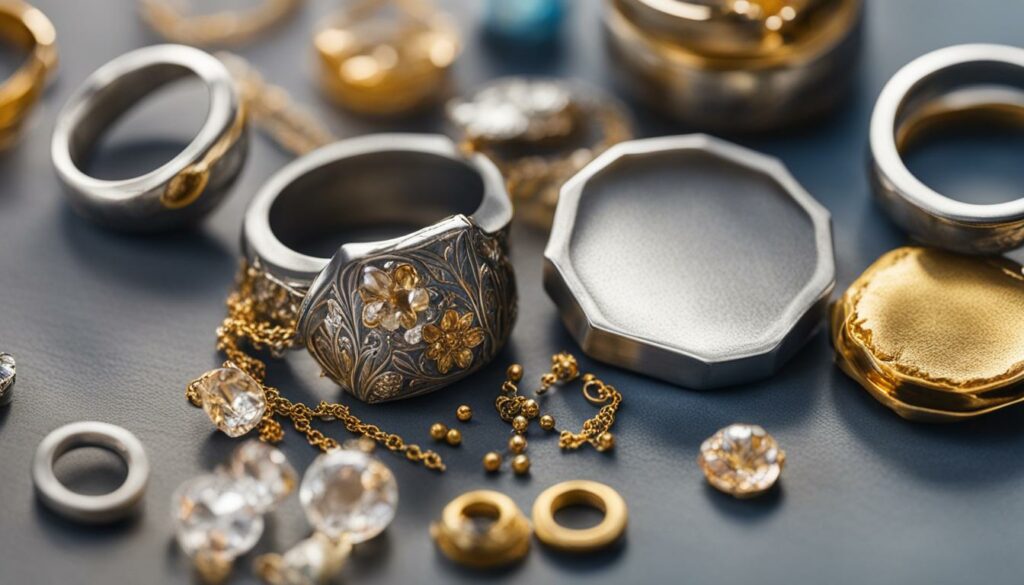
Alternative Methods for Cleaning Tarnished Jewelry
While the aluminum foil method is a popular and effective way to clean tarnished jewelry, there are also alternative methods that can be used. These DIY jewelry cleaning methods can be easily done at home and often involve ingredients that you may already have.
One alternative method is using white vinegar and water. Mix equal parts of vinegar and water in a bowl and soak the tarnished jewelry for a few minutes. Gently scrub the jewelry with a soft toothbrush, then rinse and pat dry. The acidic properties of vinegar help to dissolve the tarnish and restore the shine to the jewelry.
Another home remedy for cleaning tarnished jewelry is using lemon juice. Squeeze fresh lemon juice into a bowl and place the jewelry in the juice. Allow it to soak for a few minutes, then gently scrub with a soft toothbrush. Rinse thoroughly and pat dry. The natural acidity of lemon juice can help remove tarnish and bring back the luster of the jewelry.
Mild shampoo can also be used to clean tarnished jewelry. Mix a small amount of mild shampoo with warm water in a bowl. Place the jewelry in the solution and let it soak for a few minutes. Gently scrub with a soft toothbrush, rinse, and pat dry. This method is especially useful for cleaning delicate jewelry or pieces with intricate designs.
Table: Comparison of Alternative Jewelry Cleaning Methods
| Method | Ingredients | Process | Effectiveness |
|---|---|---|---|
| White Vinegar | Vinegar, Water | Soak, scrub, rinse | Effective for most metals |
| Lemon Juice | Fresh Lemon Juice | Soak, scrub, rinse | Gentle and effective |
| Mild Shampoo | Shampoo, Warm Water | Soak, scrub, rinse | Gentle and safe for delicate jewelry |
These alternative methods for cleaning tarnished jewelry offer a DIY solution that is both effective and cost-efficient. However, it is important to note that these methods may not be suitable for all types of jewelry. It is always best to check the cleaning instructions provided by the manufacturer or consult with a professional jeweler to ensure that the chosen method is safe for your specific piece of jewelry.
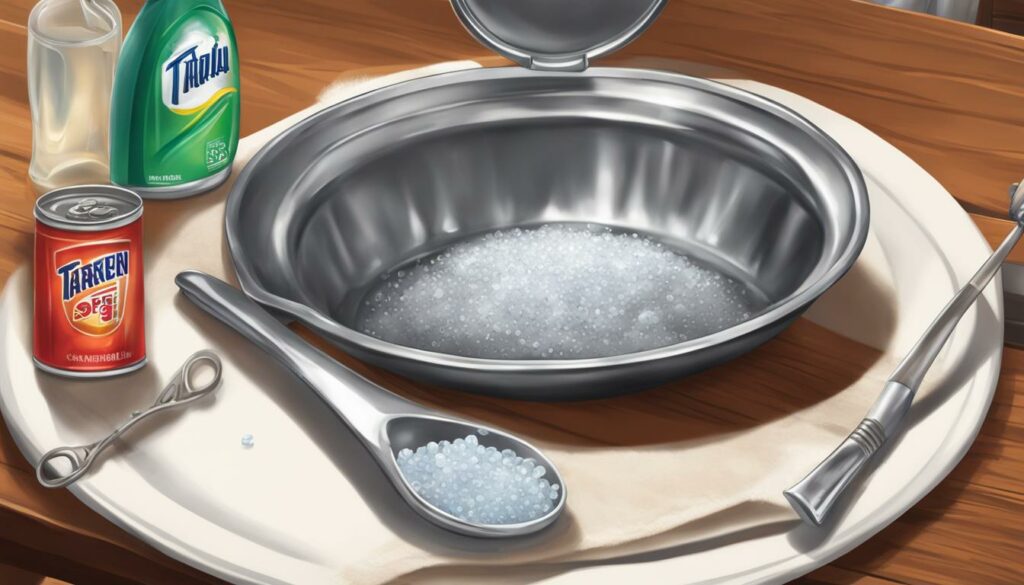
Cleaning Tarnished Costume Jewelry
If you have costume jewelry that has become tarnished, don’t worry – there are specific methods you can use to clean and restore its appearance. Costume jewelry is typically made from materials like brass, copper, or nickel, which can tarnish over time. To bring back the shine and luster of your costume jewelry, follow these simple cleaning methods:
- Using white vinegar and water: Create a cleaning solution by mixing equal parts white vinegar and water. Soak the tarnished costume jewelry in the solution for a few minutes, then scrub gently with a toothbrush. Rinse the jewelry with water and pat it dry.
- Using lemon juice: Squeeze fresh lemon juice into a bowl and dip a soft cloth or toothbrush into the juice. Gently rub the tarnished jewelry, focusing on the areas with tarnish. Rinse with water and dry with a soft cloth.
- Using toothpaste: Apply a small amount of non-gel toothpaste to a soft cloth or toothbrush. Gently rub the tarnished jewelry, using circular motions. Rinse with water and dry thoroughly.
It is important to note that these cleaning methods are suitable for costume jewelry with non-precious metals and fake gold plating. Avoid using harsh chemicals or abrasive materials that can cause further damage to the jewelry. Handle the jewelry with care during the cleaning process to prevent any accidental scratching or breakage.
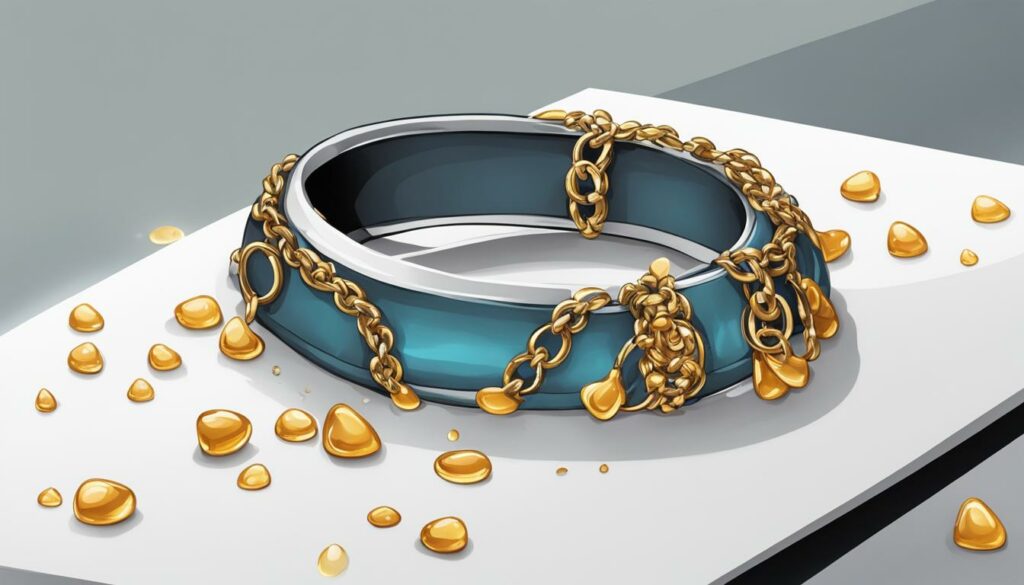
Before and After: Restoring the Beauty of Costume Jewelry
“I had a tarnished brass necklace that I thought was beyond repair, but after using the vinegar and water method, it looks brand new. I couldn’t believe the difference it made!” – Sarah, Costume Jewelry Enthusiast
By following these simple cleaning methods, you can revive your tarnished costume jewelry and enjoy its beauty once again. Remember to clean your costume jewelry regularly to prevent tarnish from building up and causing more damage. With proper care and maintenance, your costume jewelry can continue to sparkle and shine for years to come.
The Importance of Proper Jewelry Care
Proper care and maintenance of your jewelry are essential to ensure its longevity and preserve its beauty. By following some simple jewelry maintenance tips, you can keep your pieces looking their best and prevent damage or tarnish. Here are some key practices to keep in mind:
- Cleaning: Regular cleaning is crucial to remove dirt, oils, and other substances that can dull the shine of your jewelry. Use a soft cloth or a designated jewelry cleaning solution to gently clean your pieces. Avoid using harsh chemicals or abrasive materials that can scratch or damage the jewelry.
- Storing: Proper storage is equally important to prevent tangling, scratching, or tarnishing. Consider storing your jewelry in individual compartments or using soft pouches to protect delicate pieces. It’s also a good idea to keep your jewelry away from direct sunlight, excessive moisture, and extreme temperature changes.
- Handling: When handling your jewelry, try to avoid touching the stones or delicate parts directly. Instead, hold the piece by the metal or the sturdier parts. This helps prevent the transfer of oils and acids from your skin, which can affect the appearance of the jewelry over time.
“Proper care and maintenance of your jewelry are essential to ensure its longevity and preserve its beauty.”
By following these simple tips, you can keep your jewelry looking beautiful and extend its lifespan. Remember, each piece of jewelry is unique, so it’s important to consult any specific care instructions provided by the manufacturer or jeweler. With the right care, your jewelry will continue to dazzle and bring joy for years to come.
| Jewelry Care Tips |
|---|
| Clean your jewelry regularly with a soft cloth or designated cleaning solution |
| Avoid using harsh chemicals or abrasive materials that can scratch or damage the jewelry |
| Store your jewelry in individual compartments or soft pouches to prevent tangling, scratching, or tarnishing |
| Keep your jewelry away from direct sunlight, excessive moisture, and extreme temperature changes |
| Handle your jewelry by holding the sturdier parts rather than touching stones or delicate components directly |
Understanding Tarnish and Its Effects on Jewelry
When it comes to jewelry, tarnish can have a significant impact on its appearance and overall quality. Tarnish refers to the discoloration and loss of shine that occurs on metals like silver and gold over time. It occurs due to a chemical reaction between the metals and substances in the environment, such as sulfur, moisture, and oils. The effects of tarnish can make jewelry look dull, discolored, and worn-out, decreasing its value and aesthetic appeal.
One of the most noticeable effects of tarnish is the change in color. Tarnished silver, for example, turns dark gray or black, while tarnished gold may appear dull and lackluster. This discoloration can be quite unsightly and detract from the natural beauty of the jewelry. In addition to the change in color, tarnish can also cause surface scratches, nicks, and a rough texture, further diminishing the jewelry’s overall quality and desirability.
To restore the original shine and beauty of tarnished jewelry, proper cleaning and restoration techniques are necessary. Cleaning tarnished jewelry often involves the use of specific cleaning solutions or methods that effectively remove the tarnish without causing damage to the metal or any gemstones. By regularly cleaning and maintaining jewelry, it is possible to prevent tarnish from worsening and preserve the longevity and value of cherished pieces.
| Effects of Tarnish on Jewelry | Cleaning and Restoring Tarnished Jewelry |
|---|---|
| Change in color (e.g., silver turns dark gray or black, gold appears dull) | Use specific cleaning solutions or methods to remove tarnish effectively |
| Surface scratches, nicks, and rough texture | Regularly clean and maintain jewelry to prevent tarnish from worsening |
| Diminished overall quality and desirability | Preserve the longevity and value of jewelry through proper cleaning and restoration |
With a better understanding of the effects of tarnish on jewelry, it becomes evident how important it is to care for and maintain our cherished pieces. By taking proactive measures to prevent tarnish and regularly cleaning jewelry, we can ensure that it remains in optimal condition, preserving its beauty for years to come.
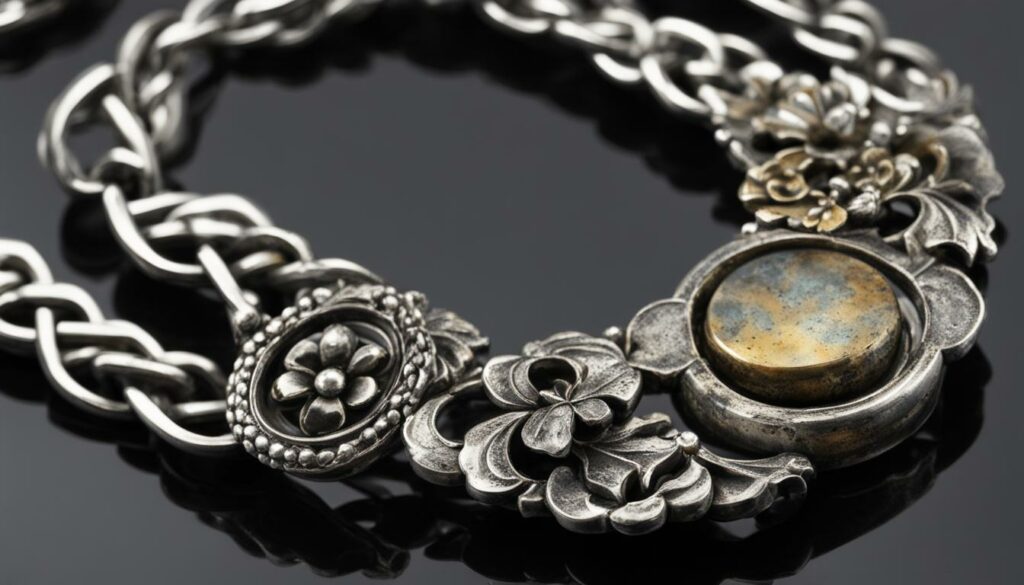
The Science Behind Tarnish and Cleaning Methods
When it comes to cleaning tarnished jewelry, understanding the science behind it can help explain why certain methods are effective. Tarnish is the result of a chemical reaction between metals in the jewelry and substances in the environment, such as sulfur or cosmetics. In the case of silver jewelry, tarnish is caused by the reaction between silver and sulfur, forming silver sulfide. This is what gives the jewelry its dull and discolored appearance.
The aluminum foil method works by utilizing another chemical reaction to remove tarnish from jewelry. By placing the tarnished jewelry in direct contact with aluminum foil, a galvanic reaction occurs between the silver sulfide and the aluminum. This reaction causes the tarnish to transfer from the jewelry to the foil, restoring the shine to the jewelry.
The aluminum foil method is particularly effective for removing tarnish from silver jewelry, as the metal has a strong affinity for sulfur. However, it is important to note that this method should not be used on jewelry with gemstones, as it can cause damage. For jewelry with gemstones, it is best to consult a professional jeweler for cleaning and maintenance.
Benefits of the Aluminum Foil Method for Cleaning Tarnished Jewelry:
- Simple and affordable: The aluminum foil method requires common household items such as aluminum foil, baking soda, and boiling water.
- Chemically effective: The reaction between silver sulfide and aluminum removes tarnish without the need for harsh chemicals.
- Safe for most jewelry: The aluminum foil method is safe for silver jewelry, but should not be used on jewelry with gemstones.
Understanding the chemical reactions involved in jewelry cleaning can empower you to effectively restore the shine to your tarnished pieces. By using the aluminum foil method or other suitable cleaning methods, you can keep your jewelry looking its best and enjoy its beauty for years to come.
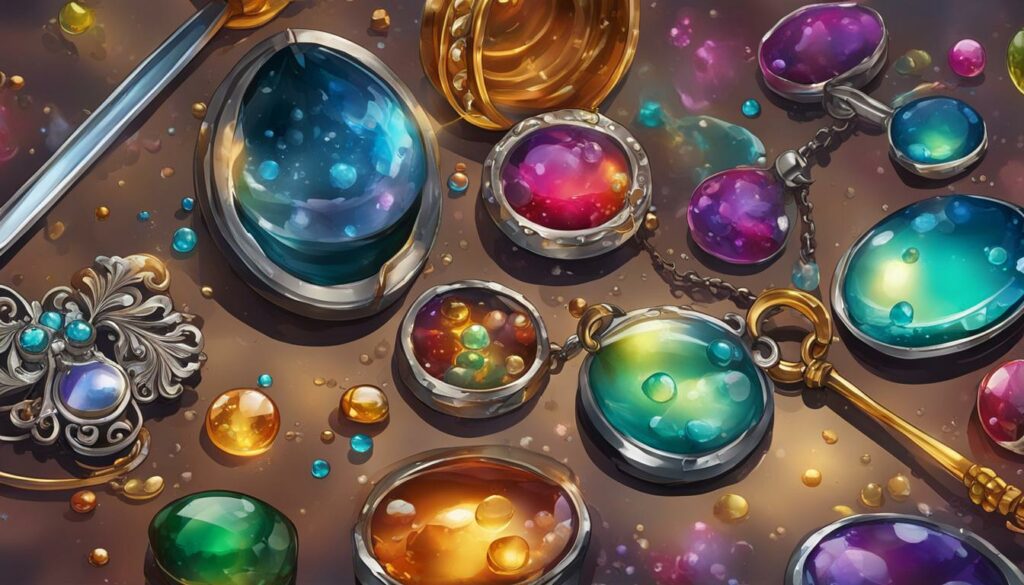
The Importance of Proper Handling During Cleaning
When it comes to cleaning tarnished jewelry, proper handling is essential to prevent any damage. By following a few simple precautions, you can ensure that your precious pieces are cleaned effectively and safely.
Gentle Cleaning Techniques
First and foremost, it’s important to use gentle cleaning techniques to avoid scratching or tarnishing the jewelry further. Avoid using abrasive materials or harsh chemicals that can damage the surface. Instead, opt for soft cloths or toothbrushes specifically designed for delicate jewelry cleaning. Take your time and be meticulous in your cleaning, paying attention to every nook and cranny.
Proper Rinsing and Drying
After cleaning, thoroughly rinse the jewelry to remove any cleaning solution residue. Use lukewarm water and gently swish the jewelry around to ensure all the cleaning solution is washed away. Avoid using hot water, as it can cause damage to certain gemstones or delicate metals. Once rinsed, pat the jewelry dry with a soft cloth, being careful not to rub too vigorously.
Handling with Clean, Dry Hands
Always handle jewelry with clean, dry hands to avoid transferring dirt, oils, or moisture onto the pieces. Moisture and oils can cause tarnish to develop more quickly, so it’s important to keep them away from your jewelry. If necessary, use a mild, non-greasy hand lotion and wait for it to absorb before handling your jewelry. This will help maintain the shine and integrity of the pieces.
By following these simple precautions, you can effectively clean your tarnished jewelry without causing any damage. Proper handling during the cleaning process is key to preserving the beauty and longevity of your cherished pieces.
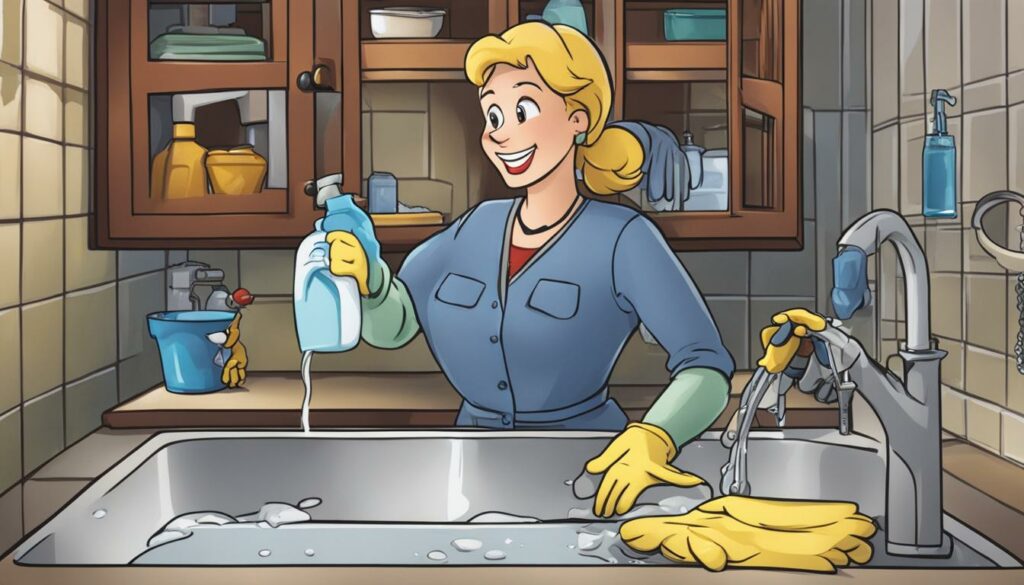
Tips for Maintaining Tarnish-Free Jewelry
Proper maintenance and care are crucial for keeping your jewelry tarnish-free and preserving its beauty. Follow these tips to ensure that your favorite pieces shine brightly for years to come:
Regular Cleaning
Regular cleaning is essential for preventing tarnish on your jewelry. It is recommended to clean your jewelry every few months, depending on how often you wear it. Use a mild soap or jewelry cleaning solution and a soft brush to gently clean the surface of your jewelry. Rinse it thoroughly with warm water and pat it dry with a soft cloth.
Proper Storage
Storing your jewelry correctly can significantly reduce the risk of tarnish. Store each piece separately to prevent scratching and tangling. It is best to keep your jewelry in a fabric-lined jewelry box or a soft pouch to protect it from moisture and air exposure. Additionally, consider using anti-tarnish strips or pouches to absorb any moisture and prevent tarnish formation.
Avoiding Harsh Chemicals
Avoid exposing your jewelry to harsh chemicals, such as perfume, hairspray, or cleaning products. These chemicals can tarnish your jewelry and cause damage over time. It’s best to apply your beauty products and perfume before putting on your jewelry to minimize contact. When cleaning your house or using any cleaning products, it’s advisable to remove your jewelry to protect it from any potential damage.
| Tips for Maintaining Tarnish-Free Jewelry |
|---|
| Regular Cleaning |
| Proper Storage |
| Avoiding Harsh Chemicals |
By following these simple tips, you can keep your jewelry looking its best and prevent tarnish from dulling its shine. Remember to clean your jewelry regularly, store it properly, and avoid exposing it to harsh chemicals. With proper maintenance and care, your jewelry will remain tarnish-free and continue to sparkle for years to come.
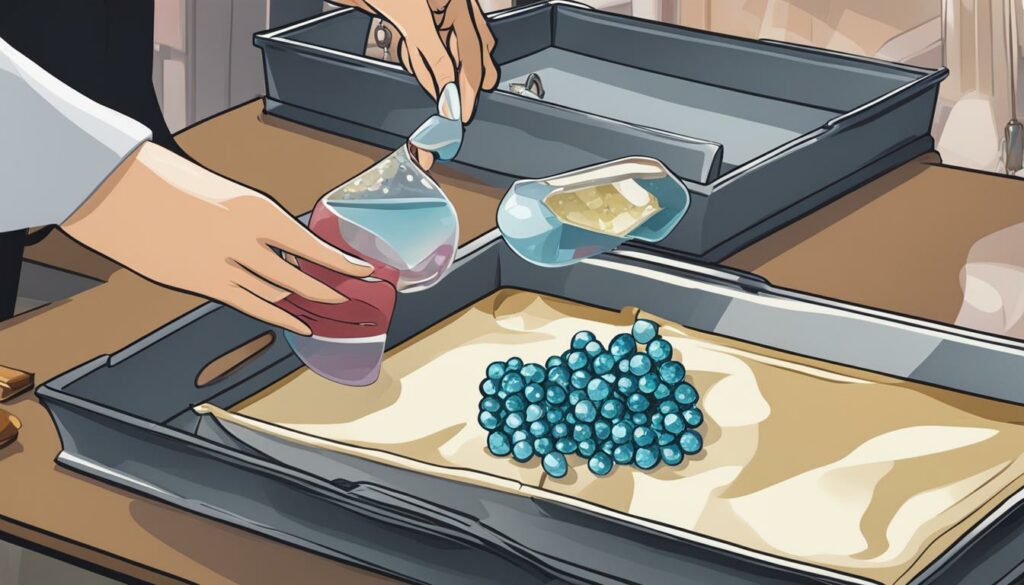
Conclusion
In conclusion, cleaning tarnished jewelry can be a simple and effective process that can be done at home. By using methods like the aluminum foil method and understanding the science behind tarnish, it is possible to restore the shine and beauty of your jewelry.
Preventing tarnish is also important, and can be achieved by proper storage, regular cleaning, and avoiding contact with substances that can accelerate tarnish formation. By following these tips, you can keep your jewelry looking brand new and enjoy it for years to come.
Remember to handle your jewelry with care during the cleaning process to prevent any damage. Use gentle materials and avoid harsh chemicals that can further tarnish or scratch your jewelry. With regular maintenance and careful handling, your jewelry will remain tarnish-free and preserve its original charm.
FAQ
How does tarnish occur on jewelry?
Tarnish on jewelry is caused by a chemical reaction between metals in the jewelry and substances in the environment, such as sulfur or cosmetics.
What is the aluminum foil method for cleaning tarnished jewelry?
The aluminum foil method involves using aluminum foil, baking soda, and boiling water to create a chemical reaction that removes tarnish from jewelry.
Can I use the aluminum foil method on gold jewelry?
Yes, the aluminum foil method can be used to clean solid gold jewelry and restore its shine.
How do I prevent tarnish on jewelry?
To prevent tarnish, store jewelry in air-tight containers, avoid exposure to moisture and chemicals, and regularly clean and maintain your jewelry.
Can I clean costume jewelry with the aluminum foil method?
Yes, you can clean tarnished costume jewelry using methods such as white vinegar and water, lemon juice, or toothpaste.
How should I handle jewelry during the cleaning process?
Handle jewelry with care, use soft materials for cleaning, and avoid using abrasive materials or harsh chemicals that could cause damage.
What are some alternative methods for cleaning tarnished jewelry?
Alternative methods include using white vinegar and water, lemon juice, mild shampoo, or a paste made from dry mango powder.
How can I maintain tarnish-free jewelry?
Store jewelry in air-tight containers, avoid exposure to moisture and chemicals, regularly clean and maintain your jewelry, and handle it with clean, dry hands.
What are the effects of tarnish on jewelry?
Tarnish can make jewelry appear dull, discolored, and tarnished, and it can also cause surface scratches and nicks.
Why is proper jewelry care important?
Proper jewelry care helps maintain the shine and appearance of jewelry, prevents tarnish, and preserves the beauty of the pieces.
Source Links
- https://www.ivjewelry.com/blogs/journal/how-to-remove-tarnish
- https://www.sincerelysilver.co/blogs/jewelry-blog/how-to-clean-tarnished-jewelry
- https://theeverygirl.com/how-to-clean-tarnished-jewelry/
